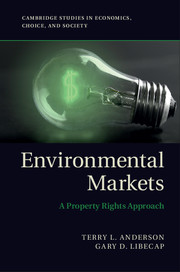Book contents
- Frontmatter
- Contents
- List of Figures and Tables
- Preface
- Acknowledgments
- 1 Who Owns the Environment?
- 2 Is Government Regulation the Solution?
- 3 Property Rights for the Common Pool
- 4 Local Property Rights to the Commons
- 5 The Politics of Property Rights
- 6 From Property Rights to Markets
- 7 Tackling the Global Commons
- 8 Property Rights and Environmental Markets
- Index
- References
1 - Who Owns the Environment?
Published online by Cambridge University Press: 05 July 2014
- Frontmatter
- Contents
- List of Figures and Tables
- Preface
- Acknowledgments
- 1 Who Owns the Environment?
- 2 Is Government Regulation the Solution?
- 3 Property Rights for the Common Pool
- 4 Local Property Rights to the Commons
- 5 The Politics of Property Rights
- 6 From Property Rights to Markets
- 7 Tackling the Global Commons
- 8 Property Rights and Environmental Markets
- Index
- References
Summary
The objective of this book is to promote greater consideration of property rights and markets in addressing environmental problems. Although there is movement toward increased use of market approaches with the adoption of cap-and-trade in controlling air emissions, fishery harvests, and land use, there have been bumps in the road. Several environmental markets are thin with few trades, in others, prices have trended toward regulatory-set floors, and many have insecure property rights that limit incentives for long-term investment and conservation. We explore why that might be the case and what options exist for, and what benefits may be derived from, expansion. We believe that more can be done to improve the efficient provision of environmental quality through the greater definition of property rights and market exchange.
THE RECIPROCAL NATURE OF THE PROBLEM: NORMATIVE AND POSITIVE ANALYSIS
The manner in which our approach differs from standard presentations is that we recognize environmental problems as ones of reciprocal costs. Natural resource and environmental problems arise when people with diverse demands compete for the use of environmental goods. For example, the policy debate over air pollution levels reveals competition between those who want to use the air for low-cost waste disposal or to facilitate use of certain fossil fuels and those who want to breathe clean air, avoid the health effects of ingesting contaminants, have clear views of the surrounding terrain, or mitigate potential climate change. Debates over clear-cut forests reflect competition between those who demand wood products at low cost and seek maintenance of timber-based industries and communities and those who prefer forests for hiking trails, wildlife habitat, or carbon sequestration and the expansion of ecotourism. Concerns about overfishing indicate competition between those who want fish now, regardless of stock impacts, and those who want a sustainable yield into the future. In a positive sense, these are competing and conflicting demands. The different effects on welfare if one use dominates the other often are not obvious, although advocates on both sides have clear opinions. The ultimate answer depends upon the benefits and costs of each alternative and their distribution across society.
- Type
- Chapter
- Information
- Environmental MarketsA Property Rights Approach, pp. 1 - 20Publisher: Cambridge University PressPrint publication year: 2014



